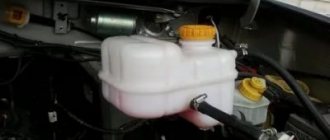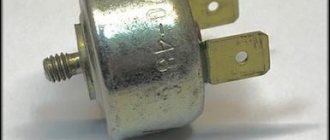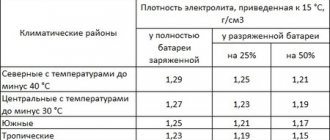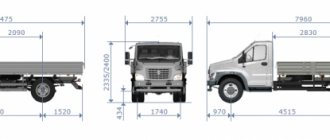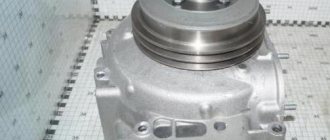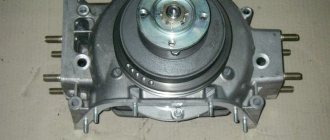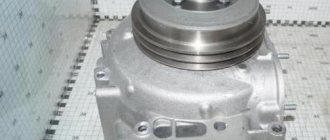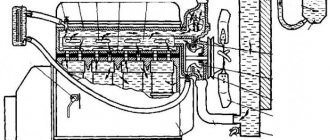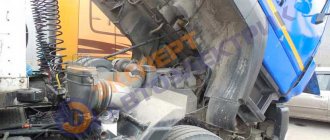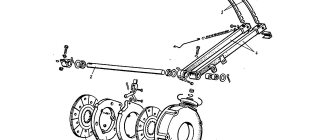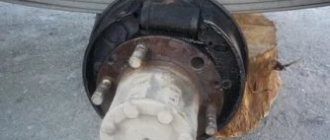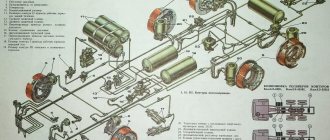To engage 5th gear, you need to move the lever to the right, overcoming resistance, then move it forward. Reverse gear is engaged only when the car is stationary and not earlier than three seconds after squeezing the clutch pedal. SWITCHING TRANSFER CASE MODES
Using the transfer case control lever, the driver can choose between normal and all-wheel drive driving modes.
The transfer case does not have a neutral position, so its control lever must always be securely installed in one of the possible three positions (“2H”, 4H or “4L”). Mode "2H"
designed for vehicle movement on normal road surfaces, provides maximum fuel economy and minimal background noise.
When turning on this mode, you must disable the manual locking of the front wheel hubs (models with manual locking of the hubs - see below). The “4H” mode
provides optimal conditions for driving on wet or icy road surfaces.
Don't forget to turn on the manual locking of the front wheel hubs. The vehicle speed should not exceed 100 km/h (60 mph). The “4L” mode
provides maximum engine output power and is intended for use when driving a vehicle in mountainous terrain, off-road, sand, mud or deep snow.
Manual locking of the front wheel hubs must be turned on. The vehicle speed should not exceed 40 km/h (25 mph). Shifting the transfer case control lever does not require depressing the clutch pedal. Switching from the “2H” mode to the “4H” mode on the move is only possible if the manual locking of the front wheel hubs is already turned on (models with manual hub locking). Warning
Do not under any circumstances switch the transfer case from the “2H” mode to the “4H” mode while driving if the manual or automatic locking of the front wheel hubs is not turned on! The gearbox can be switched from “4H” mode to “2H” mode at any vehicle speed, without the need to depress the clutch pedal. Warning
Switching the transfer case from the “4H” mode to the “4L” mode and back should only be done with the vehicle stationary! Models with automatic front wheel hub locking
| EXECUTION ORDER |
When the transfer case is switched to the “4H” or “4L” mode, the hub locking is turned off instantly and turns back on when the direction of travel changes.
Models with manual hub locking
To disengage the clutch lock, turn it counterclockwise and bring it to the “FREE” position (see ibid.).
FEATURES OF DRIVING 4WD VEHICLES
Driving on the highway in the cold season
The increased traction of all-wheel drive models provides the vehicle with better handling when driving in difficult road conditions, particularly in deep snow and heavy icing. However, all-wheel drive does not provide anti-skid protection in any way. Moreover, it is often easier to recover a rear-wheel drive or front-wheel drive vehicle from a skid than in the case of 4WD models. In view of the above, you should not abuse the inclusion of all-wheel drive modes when driving on shallow snow or ice crust. – Depending on the specific conditions, switch the transfer case to the “4L” or “2H” mode; – Start the engine, engage a low gear and start moving at the lowest possible speed, manipulating the gas and clutch pedals; – Try to avoid excessive clutch slipping; – Try to shift the transmission into higher gear as quickly as possible and make sure that the engine speed does not increase excessively.
Off-road driving
When the deterioration of the road surface makes it necessary to engage the all-wheel drive mode, try to comply with the following basic requirements: – Drive reasonably slowly, in low gears, taking into account the road and weather conditions; – To drive the car, try to use the gas pedal, minimizing the use of the brakes; – Try not to let the clutch slip
and turning the wheels; – Avoid sharp turns of the steering wheel. Try to take into account all weather and road factors - use common sense and try to soberly assess the capabilities of the car. Before you go on a long trip, plan your route in advance. Before departure, check the technical condition of the car.
OVERCOMING WATER OBSTACLES
Try not to go into deep water. Before starting the crossing, study the bottom relief of the obstacle and choose the most gentle entry into the water. Shift the transfer case to the “4L” position and engage first gear. Try not to allow the engine speed to jump to prevent water from entering the exhaust system if the exhaust pipe cut is below the surface. Drive at a speed of no more than 5 km/h (3 mph) and try not to create a lot of splashes. Try not to move against the current. If this is not possible, try to turn the car at such an angle to the current vector that the incoming water does not pour into the engine compartment. Avoid splashing into the engine compartment to prevent engine shutdown due to moisture in the ignition system components. Make sure that water does not get into the engine air intake, as this can lead to jamming and the need for expensive repairs. After successfully overcoming a water obstacle, check the proper functioning of the brakes. To speed up the drying of the working surfaces of the brake mechanisms, slow down the car several times while driving at low speed. As soon as possible, check whether water has entered the air cleaner filter element, the engine, transmission, axle housings, or the vehicle interior. Replace any lubricants that have acquired a milky consistency, which is evidence of water getting into the oil.
PRECAUTIONS WHEN DRIVING IN 4WD MODES
When driving in 4WD modes, some special precautions should be taken. To avoid failure of transmission components and the risk of loss of control, avoid using the vehicle in four-wheel drive modes with the front wheel hubs locked when driving on dry hard road surfaces (asphalt). On models with automatic locking of the front wheel hubs, no alarm is provided to notify the driver that the lock is engaged, therefore, if you are not sure about the state of the locks (for example, when changing the driver), just in case, you should carry out the procedure for disabling the lock. Remember that the center of gravity of SUVs is usually quite high above the ground, which should be taken into account when choosing how to drive - do not try to make turns at the same high speed as you do in regular cars. Strong crosswinds can also have a noticeable effect on vehicle handling. Try to reduce your speed during particularly strong squalls.
UAZ-469, a legendary SUV, popularly nicknamed “Kozlik” or “Bobik”, rolled off the assembly line of the Ulyanovsk plant back in 1972. Although its production ceased in 1985, many car enthusiasts still remember this car as one of the best cars with amazing cross-country ability.
Most owners note that the UAZ 469 is capable of passing any obstacles with ease and is not afraid of scattered stones on the road, steep slopes, or deep fords. However, having such a car, many argue that you need to know how to properly maintain it, so for those who have recently purchased this car or are just looking to make a purchase in the near future, we will reveal the most important subtleties of its operation.
Car UAZ-469 instrument panel instrumentation UAZ-469
Details Category: Operation of UAZ-469 UAZ-469 instrument panel
Rice. 8. UAZ-469 - instrument panel.
Coolant temperature indicator 7 shows the temperature of the liquid in the cylinder block when the ignition is on. The sensor for this indicator is located in the water pump bracket. On the UAZ-469 instrument panel, warning lamp 8 for emergency overheating of the coolant with a red lens lights up when the liquid temperature is above 106...109°C. The sensor is located in the upper radiator tank. The 9th fuel level indicator has a scale with 0 divisions; 0.5; P, corresponding to the empty, half and full capacity of the tank. The fuel level indicator is equipped with two sensors, according to the number of tanks, and shows the amount of fuel in each tank separately. To turn on the right or left tank sensor, there is a switch 12 on the instrument panel, which has two positions: down - the right tank sensor turns on; up - left tank sensor. The indicator is only valid when the ignition is on. Switch 10 of the body light. Handle 11 is used to manually control the carburetor throttle; When the handle is pulled out, the damper opens. The position of the handle can be fixed by rotating it 90° around its axis. The handle must be recessed while the vehicle is moving. The combined ignition and starter switch 13 (lock) (Fig. 9) has three positions: middle - off, first right - ignition on; second (far right) - ignition and starter on; third left - the receiver is turned on (when it is installed). Handle 14 (Fig. of the central light switch is used to turn on the headlights, headlights, rear lights and instrument lighting lamps. The switch handle has three fixed positions: the first - everything is off; the second - the front lights are on (or low beam headlights depending on the position of the foot light switch), rear lights and instrument lighting; third - low or high beam headlights are turned on depending on the position of the foot light switch, rear lights and instrument lighting. By turning the switch knob, the intensity of instrument lighting is adjusted.
Rice. 9. Key position in the UAZ-469 ignition switch: O - neutral position; I — ignition is on; II - ignition and starter are on; III — the receiver is turned on (if installed).
Switch 15 of the electric motor of the body heater can be set to three positions: by moving the switch handle up, an increased speed of rotation of the electric motor shaft is turned on, by moving the handle down, a reduced speed of rotation of the electric motor shaft is turned on, with the handle in the middle position, the electric motor is turned off. On the UAZ-469 instrument panel, handle 16 is used to manual control of the carburetor air damper; by pulling the handle, you can partially or completely close the air damper - the working mixture is enriched. After the engine warms up, the handle should be recessed. The position of the handle can be fixed by rotating it around its axis by 90°. Switch 1 is designed to control the operation of the windshield wiper and washer; turning clockwise turns on the wiper, and pressing the handle in the axial direction turns on the washer. Button 18 thermal fuse in the lighting circuit. 19 — alarm switch. To turn on, pull the handle towards you.
What is included in the electrical circuit
What features do automotive electrics have on old cars produced by the Ulyanovsk Automobile Plant?
Electronic components
The electrical circuit of the UAZ 452 itself is quite simple - single-wire.
By its design, the wiring diagram of a UAZ390995 or other model is characterized by the following solutions:
- The vehicle body is used as the mass.
- Any electrical equipment of the old-style circuit on a UAZ 409 or other model, as well as actuators, are equipped with a negative terminal, which is connected to the car body. According to experts, in general this scheme is imperfect.
According to the operating instructions for electrical equipment, the driver must periodically diagnose the condition of the integrity of the contacts. We are also talking about their oxidation. If the driver notices the presence of oxidation on the terminals, he should treat them using fine-grained sandpaper.
Engine compartment
In this case, the engine compartment is located directly in the passenger compartment in accordance with the design of the car.
Access to the electrical circuit and other mechanisms and assemblies is made from the interior, as a result of dismantling the cover, which:
- Designed to protect the motorist and passenger from exhaust gases entering the cabin.
- Allows you to protect the car interior from the penetration of dirt and dust.
- Performs the function of an additional heating device, in particular passively, as a result of heating.
Previously, the UAZ 396255 and other models with a carburetor used an engine from the legendary Pobeda, which was later replaced with a more improved and modern unit. In particular, it means a Volga engine. This decision at one time, back in 1964, was facilitated by the serial launch of a production line at the ZMZ enterprise. Despite the fact that many domestic car enthusiasts claim that the UAZ 390994 injector circuit in the engine compartment is located in an inconvenient place due to the lack of a hood, this is not so. Decades of operation have proven that the absence of a hood in no way affects the diagnosis and maintenance of the car.
Passive safety
The very design of the domestic Loaf with the absence of a hood at first raised many questions in terms of the safety of the driver and passengers. As a result of several dozen crash tests that were carried out back in the early 70s of the last century, it was revealed that the car is no less safe when compared with other domestic cars. As the results showed, in the event of an accident, both the driver and passengers of the car have a good chance of avoiding injury in an accident.
How the UAZ front axle works
Car enthusiastsRemoving and replacing the gearbox of the VAZ-2107Post navigationPopular articlesSections of the site
The diagram of the UAZ loaf front axle allows us to determine that it consists of several components:
- Composite crankcase;
- Gearbox;
- Half shafts
Below is the structure of the components of the front axle of the UAZ loaf car.
Carter
The UAZ loaf axle housing consists of 2 parts. The parts are bolted together to form a gearbox housing. Parts of the crankcase are equipped with fastenings for installing springs and shock absorbers.
There are turning mechanisms along the edges of the bridge. They are necessary to drive a car. The mechanisms are pivotally connected to the edges of the crankcase casing. Trunnions are installed on the rotating mechanisms. They are necessary for articulated connection with the vehicle hubs. To reduce the degree of friction, the hub is mounted on roller bearings.
Gearbox
The UAZ loaf front axle gearbox consists of a main gear and a cross-axle differential. When the front axle of the UAZ loaf is turned on, the torque from the gearbox is supplied through the driveshaft to the gearbox flange. It is mounted on the same shaft with the main gear drive gear.
As the drive gear rotates, it transmits torque to the driven gear. Compared to the drive gear, it has a large diameter. This allows you to reduce the torque transmitted from the transfer case.
An interwheel differential is located inside the driven gear. It consists of conical satellites and their axes. The differential mechanism includes axle shaft splines. The differential allows, when turning a car, to achieve a difference in the speed of rotation of the wheels of one axle. You can also read about UAZ 390945.
Half shafts
The front axle of the UAZ loaf car is a shaft with splines on the edges. On the one hand, the splines are installed in the differential gearbox. The second side of the axle shaft drives the wheel hub. The transmission of torque from the front axle gearbox to the wheel mechanism is carried out using a CV joint. It allows you to transmit torque regardless of the angle of rotation of the wheel mechanisms.
A distinctive feature of the front axle of the UAZ Bukhanka is the ability to disconnect the wheel hubs from the axle shafts. This is necessary to prevent wear of the rotating parts of the gearbox during prolonged movement on good quality surfaces.
Algorithm of operation of multifunction switches
Car enthusiastsReplacing the camshaft drive chain tensioner VAZ-2107Post navigationPopular articlesSite sections
The new scheme has caused many complaints from car owners with its “confusing” algorithm. However, a similar scheme is widely used on imported cars and is considered safer when driving.
Possible positions of the multifunctional steering column switch: A – headlights and direction indicators, B – windshield wiper and washer
The headlight and indicator light control lever indicated in the picture “A” has the following algorithm:
- Position I – low beam is turned on (if the central switch on the instrument panel is activated). In this case, the direction indicators are turned off;
- Position II (non-locking) – turning on left;
- Position III (fixed) – turning on the left turn;
- Position IV (non-locking) – turning on the right turn indicator;
- Position V (fixed) – enabling right turn;
- Position VI (lever toward you) – turning on the high beam (non-fixed position);
- Position VII (lever away from you) - turns on the high beam headlights, provided the central switch on the instrument panel is turned on (fixed position).
The control lever for windshield wipers and windshield washers, indicated in picture “B,” has the following positions:
- Floor. I – the cleaner and washer drives are de-energized;
- Floor. II (non-latching) – intermittent operation of the windshield wipers is activated;
- Floor. III (fixed) – similar to item 2;
- Floor. IV (fixed) – low speed of constant wiper mode;
- Floor. V (fixed) – high operating speed of the constant purifier mode;
- Floor. VI (lever toward you) – simultaneous short-term activation of the washer and windshield wiper (non-fixed position);
Position VI is required in emergency situations when an oncoming car splashes mud on the windshield. Simultaneous operation of the wipers and washer allows you to quickly restore visibility.
Pros and cons of UAZ-315195 Hunter
Car enthusiastsRemoving and replacing the throttle actuator VAZ-2112Post navigationPopular articlesSite sections
For a person who does not know the history of the model, complaints, as a rule, are caused by the front doors being too narrow, with a doorway beveled at the rear. This form was developed back in the sixties, during the period of preparation for the production of the UAZ-469, during the development of which the legendary Willys MB remained the model for the design of all-wheel drive SUVs. The American jeep had a short wheelbase, so immediately after the front door opening (which the Willys, by the way, did not have), the frame rose sharply, forming a voluminous wheel arch. Considering the fact that the car was very tall, for ease of entry the opening went as far as possible to the very bottom (the same approach can be observed in the design of modern tractors, in which a ladder is mounted at the bottom of the opening). The UAZ-469 was equipped with doors for comfort; in addition, its base was extended as much as possible without losing off-road qualities, but not so much as to accommodate full-size doors providing access to the front and rear seats. The doors turned out to be narrow, which is why it is so difficult to squeeze into the modern Hunter.
For the same reason – the legacy of the “military past” – Hunter’s stove, firstly, is noisy, and secondly, it does not heat the interior evenly enough. In the spartan interior of an SUV, it is problematic to create an extensive air duct system, since there is nowhere to hide it.
For the same reason - the imperfection of the original design of the front panel, the air ducts designed to dry the windshield are not effective enough. During the creation of the UAZ-469, wiping the windows from the inside was a common practice for truck drivers, and besides, the army prototype was intended primarily for use with an open top so that it could be quickly dismounted.
Owners of previous models also noted the inconvenient placement of the pedals, and this problem is still not solved in the Hunter. The clutch pedal is too tight, the brake pedal is several centimeters higher than the gas pedal, and is located too far from the floor, which causes some inconvenience. In addition, the pedals are located in such a way that, when operating the gas and brake, the driver often touches the gear shift lever with his knee.
The same well-known disadvantage is the operation of a manual transmission - sometimes you have to depress the clutch two or three times to get into the desired gear. This is in no way a defect, but a design feature of the box.
Driving a car with a solid front axle and a worm-type steering gear will also be unusual for a person accustomed to driving conventional cars, in which the steering is much sharper. Even in the absence of play on the new Hunter, you have to “catch” the road, and this is also a design feature, and not a defect of the car.
However, all these minor shortcomings, which are caused by the design features of the SUV, which generally retains the characteristic features of a military vehicle, are certainly made up for by its amazing cross-country ability. It is impossible to buy an SUV with such properties and for the money that Hunter is sold for, and it can only be replaced with an old “jeep” purchased on the secondary market with a huge mileage and, often, many breakdowns. There are no new cars of this class and with such cross-country ability, so in its niche the UAZ Hunter has no alternative. All its shortcomings are caused by the fact that the company had to turn a Spartan military jeep into a modern vehicle, the design of which does not always allow it to solve the task, but the Hunter has enormous potential and meets the purposes for which it is intended.
What is included in the electrical circuit
What features do automotive electrics have on old cars produced by the Ulyanovsk Automobile Plant?
Electronic components
The electrical circuit of the UAZ 452 itself is quite simple - single-wire.
- The vehicle body is used as the mass.
- Any electrical equipment of the old-style circuit on a UAZ 409 or other model, as well as actuators, are equipped with a negative terminal, which is connected to the car body. According to experts, in general this scheme is imperfect.
According to the operating instructions for electrical equipment, the driver must periodically diagnose the condition of the integrity of the contacts. We are also talking about their oxidation. If the driver notices the presence of oxidation on the terminals, he should treat them using fine-grained sandpaper.
Engine compartment
In this case, the engine compartment is located directly in the passenger compartment in accordance with the design of the car.
Access to the electrical circuit and other mechanisms and assemblies is made from the interior, as a result of dismantling the cover, which:
- Designed to protect the motorist and passenger from exhaust gases entering the cabin.
- Allows you to protect the car interior from the penetration of dirt and dust.
- Performs the function of an additional heating device, in particular passively, as a result of heating.
Engine compartment of an AUZ car
Passive safety
The very design of the domestic Loaf with the absence of a hood at first raised many questions in terms of the safety of the driver and passengers. As a result of several dozen crash tests that were carried out back in the early 70s of the last century, it was revealed that the car is no less safe when compared with other domestic cars. As the results showed, in the event of an accident, both the driver and passengers of the car have a good chance of avoiding injury in an accident.
The device of the UAZ Bukhanka transfer case
The UAZ Bukhanka transfer case is a two-stage design without a differential between the axles. The mechanism is also equipped with a neutral message and switchable front wheels. The components are placed in a tray made of cast iron and equipped with a plug. The pallet is attached to the back of the box through the holes of the plates. In addition, the components of the handbrake are also attached here. The main and transition shafts of the box, the drives of the front and rear wheels, are secured by bearings. Between the supports that facilitate the rotation of the shaft, a gear is placed that drives the speed measuring device. The top of the box has an inspection hatch protected by a shutter.
Dymos transfer case for UAZ (finishing):
The control contains two rods with forks attached to a plug. The fork-shaped rods work in tandem with the drive gear and the activation gear for the front pair of wheels. Two control rods are connected to the forks by means of movable pins. There is also a blocking sphere that prevents the activation of low gear when the front wheels are not working.
By activating direct transmission, the UAZ Bukhanka transfer case acts in a similar way so that the main gear moves into the slot of the gear shaft of the rear pair of wheels, transporting the impulse directly. Activating the low gear shifts the main gear so that the impulse is transported to the intermediate shaft and to the gears that drive the axle. Activation of the low stage is only possible after the machine has come to a complete stop.
UAZ Bukhanka transfer case diagram:
Causes of breakdowns
As a rule, the need to replace the main components of a gearbox arises due to their natural wear and tear.
Causes of gearbox breakdowns
The main reason for oil leakage from the gearbox is the presence of an increased level of fuel in the system. For UAZ gearboxes, you should use high-quality oil. If the liquid is not of the proper quality, this may cause characteristic noises from the box. When the synchronizer or its parts wear out, it is always difficult to change gears
You should also pay attention to the details of the switching mechanism. When gear teeth are deformed, gears often switch off automatically
Continuity of components and assemblies
During the years of planned economic management, the price of cars was set centrally. And in order to keep costs in line, the automaker was forced to unify parts - use the same components and assemblies on different models at once.
UAZ 3303 wiring diagram
In particular, the electronic components and all electrical wiring of the UAZ 3303 were used from the “452” model, a multi-purpose all-wheel drive vehicle that rolled off the factory assembly line in those years and was involved in cargo transportation throughout the country:
- Rechargeable battery brand 6ST-60EM;
- Alternating current generator G250-P2 with integrated voltage regulator PP132-A;
- Electric starter type ;42.3708;
- Ignition coil B116
- Distributor (ignition distributor 33.3706);
- Electronic (transistor) switch model 13.3734;
- Spark plugs type A11
Regular paddle switch
On the model of the first years of production, the instrument panel from the UAZ 3741 model was installed with virtually no changes. Therefore, the circuits for connecting electronic systems remained the same.
Common instrument panel for models 3741 and 3303
To control lighting devices and turns, a conventional type steering column switch was used, which had fixed positions:
- The direction indicator had 3 positions - turn left, right and off;
- The warning lamp (in diagram No. 6) informed the driver about his mode;
- The headlight switch (low and high) had two modes - only low and only high. The enabled mode was displayed using a warning lamp (in diagram No. 8) inside the speedometer.
Classic scheme of a modified UAZ 3303-6 with conventional controls
At the same time, the windshield wiper and washer controls (no. 23 in the instrument panel diagram) were located under the hazard warning switch button and had the following algorithm:
- The purifier was activated by rotating the handle;
- Pressing the handle (meaning recessing the rod in the axial direction) activated the washer.
Platform for conveyor models
The “Loaf”, which became famous, thanks to its all-metal body, the “452” model served as a platform for the creation of an entire line of vehicles:
- UAZ 2206 – a minibus designed for 11 people;
- UAZ 3962 – vehicle for emergency medical services;
- UAZ 396255 - a civilian modification of an ambulance for the needs of rural areas;
- UAZ 39099 – promoted under the name “Farmer”. Designed for 6 passengers and 450 kg of cargo;
- UAZ 3741 – a van for transporting 2 passengers and 850 kg of cargo;
- UAZ 3303 – an onboard vehicle with an open body;
- UAZ 3904 is a cargo-passenger version that combines the convenience of an all-metal body for passengers and an open body for cargo.
